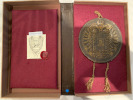Wachssiegelplatten
of von Maria Theresia v. Österreich.
ITEM # 2. 263 x 165 mm. The seal housed in a solid clam-shell box with red felt cushioned cloth. The boards dark brown cloth and dark brown leather quarter spine with raised bands. 2 red labels with gilt lettering. A handsome item.
- Since the 15th century, Royals and lesser important persons had their own seals created to seal their own official letters/envelopes etc. The seal would be in the form of a large desk seal, seal fob or very small seal ring. The original seal would be especially commissioned and be of excellent clarity and quality. When the seal was bought, the seal engraver would send through a sample wax impression in a fine lidded case for the purchaser to check the clarity of the impression. This Royal Seal wax impression presented to Maria Theresa of Austria is such an example. The seals were also made to be attached to important royal deeds, charters etc. These deeds were in parchment or velum and would sometimes be signed by the Queen. They would mostly be chirographs or indentures. Maria Theresa Walburga Amalia Christina: 13 May 1717 to 29 November 1780, was the only female ruler of the Habsburg dominions, ruling from 1740 until her death in 1780. She was the sovereign of Austria, Hungary, Croatia, Bohemia, Transylvania, Mantua, Milan, Lodomeria and Galicia, the Austrian Netherlands, and Parma. By marriage, she was Duchess of Lorraine, Grand Duchess of Tuscany and Holy Roman Empress. Maria Theresa started her 40-year reign when her father, Emperor Charles VI, died in October 1740. Though she was expected to cede power to her husband, Emperor Francis I, and her eldest son, Emperor Joseph II, who were officially her co-rulers in Austria and Bohemia, Maria Theresa was the absolute sovereign who ruled with the counsel of her advisers. She promulgated institutional, financial, medical and educational reforms, with the assistance of Wenzel Anton of Kaunitz-Rietberg, Friedrich Wilhelm von Haugwitz and Gerard van Swieten. She also promoted commerce and the development of agriculture, and reorganised Austria's ramshackle military, all of which strengthened Austria's international standing. However, she despised the Jews and the Protestants, and on certain occasions she ordered their expulsion to remote parts of the realm. She also advocated for the state church and refused to allow religious pluralism. Whatever her weaknesses her reign produced lasting benefits.





click on image to enlarge

category
ref number:
11350